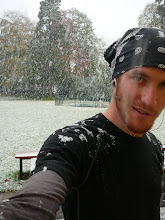Koya-san is the headquarters of the Shingon school of Esoteric Buddhism, and as such has a wonderfully free feel to it - although this could also be due the fact that it's quite secluded and situated near the peak of a mountain. You often will see a monk walking down the street doing some shopping for his monastery, or even nipping into a restaurant for some lunch. You will also not be able to avoid seeing a temple or two while you're up there with over 110 still standing and in everyday use - at one point there were about 1500 (!) before, in the 17th century, the Tokugawa shogunate (dictatorship) forced the destruction of the majority of the monasteries due to "religious differences".
The biggest cemetary I've ever seen is located in this town. It's name: Okuno-in. During the 2km long walk to the Toro-do (Lantern Hall) at the top of the complex, I was absolutely overwhelmed by the number of tombs stretching on for hundreds of metres out from either side of the cobbled path. Images of Buddha are abundant throughout the cemetary and it's assumed that any serious Buddhist in Japan has their body (or even just a lock of hair) buried here ready for when the future Buddha and the founder of Shingon Buddhism, Kukai, returns.
The Toro-do itself is amazing with hundreds of hanging lanterns dimly lighting the interior. Two of these lanterns are believed to have been burning for over 900 years (although the when I looked I couldn't see any that were not using electric bulbs). In the centre of the hall, amongst the rows and rows of religious texts, kneeling on a cushion in front of a table covered with gold instruments and a statue of Buddha was a solitary monk chanting in that low-pitched, reverberating, yet soothing and awe-inspiring tone we all picture when we think of monastic prayer. It was something else. Difficult to explain, and certainly difficult to forget. All of my senses were focussed on that moment. My eyes on the monk, my ears on his voice, my nose on the smell of incense, my fingers on the cool touch of the brass handrail in front of me.
That evening we stayed in Henjoko-in, a temple run by a group of relatively young monks. They prepared dinner for us (strictly vegetarian, of course), but not before we took a dip in a hot bath to cleanse ourselves ready for the meal - in Buddhism, even eating is a way of learning the Buddhist ways and cleansing is always necessary before any learning is commenced. After dinner, we had the honour of meditating under the instruction of our very helpful (and English-speaking) monk, Suzuki, and under the watch of Siddartha, his translucent image painted on the wall in front of us.
An early night made way for an early morning. I awoke at 5am to watch the sunrise, but because of the surrounding forest I didn't get a chance to actually see the sun before heading back to the temple to experience the monks' morning ritual. At 0630hr, they chanted words from the ancient texts in front of them while others prayed to Buddha in their presence. Again, this was performed under the low light of yellow-orange lanterns. An hour later the monks finished chanting and we were served quite a traditional Japanese breakfast (again vegetarian).
Just before we departed we were able to paint, using calligraphy, an image of Buddha. Mine was an extremely detailed picture of Vairocana, the Buddha of the Universe, which took well over an hour to complete. Once finished, Suzuki chanted a short verse to bring some of the spirit of Buddha into us and our paintings. That was a touching gesture!
This was probably one of the most memorable parts of my time in Japan...
Our time on Koya-san certainly felt very limited, but we only had a few days left in Japan and we still had not been to Osaka. So we said our goodbyes and made our way back down the mountain to Wakayama, where we said our goodbyes to Kevin as well and picked up our stuff ready for the train.
on our way up the mountain
the cable car
Okuno-in
studying the headstones
such beauty
Pilgrims pour water on the many manifestations of Buddha in return for blessings
Dinner!
the image of Buddha representing the moon under which we meditated
don't forget to remove your shoes...











1 comment:
I am so glad that you both have had such special experiences over there..
.. these are things you might never have felt in your whole life if you didn't do this now.. treasure your memories
Post a Comment